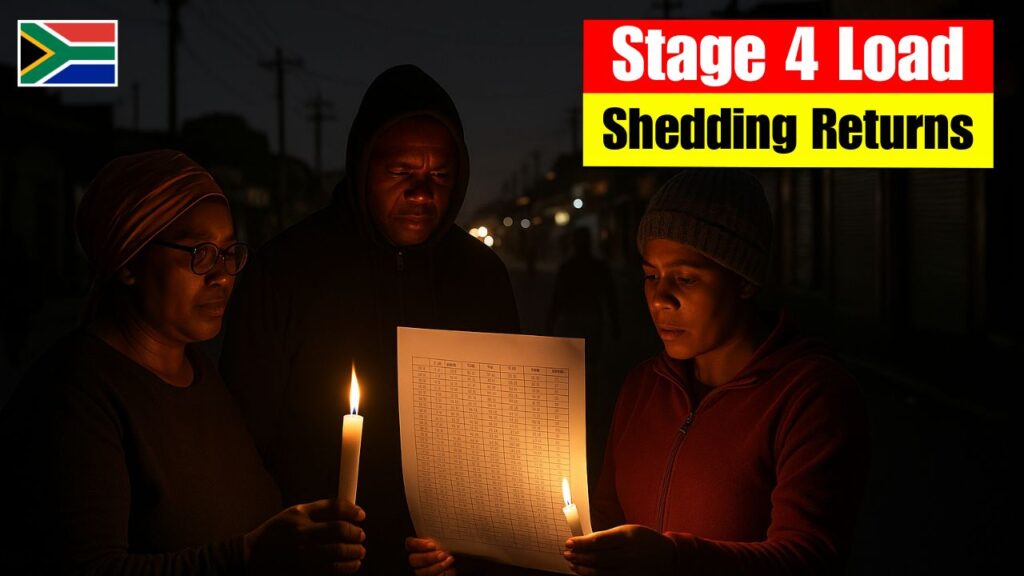As South Africa prepares for another period of extended Stage 4 load shedding the country faces familiar energy management struggles once again. This persistent problem impacts millions of people and businesses while disrupting everyday life and creating difficulties across different sectors. November introduces a new outage schedule that requires South Africans to adjust their routines and make plans around these power cuts. The country continues working to match electricity demand with available supply, making it essential for people to understand what this means and prepare themselves properly.

How Prolonged Stage 4 Load Shedding is Disrupting Daily Life in South Africa
Prolonged power outages in South Africa create serious problems for people & companies across the country. These blackouts affect everything from everyday activities to the overall economy. Families struggle to handle simple household needs because the electricity cuts interrupt cooking and heating while also affecting water availability in many areas. Small & medium-sized businesses face the biggest challenges as they try to keep operating normally. Many of these companies lose money because they cannot maintain regular business hours or complete their work on time. The education system also suffers greatly from these power cuts. Schools and universities deal with constant schedule changes that make it hard for students to learn effectively. Online classes become nearly impossible when the internet goes down with the electricity. Teachers cannot follow their lesson plans and students fall behind in their studies. The situation creates stress for everyone involved in education from elementary schools to higher learning institutions.
– Disrupted daily activities
– Economic challenges for businesses
– Impact on education sector
– Challenges in healthcare services
– Increased reliance on alternative energy sources
Newly Released November Load Shedding Timetable for Households & Businesses
The November load shedding schedule has been updated based on current energy demands and supply limitations. The schedule is different for each region so residents need to check the outage times for their specific area. Knowing these schedules helps people plan their daily activities & reduce disruptions. Eskom has released a detailed timetable for November that divides areas into different blocks to make sure power cuts are distributed fairly.
| Region | Load Shedding Block | Weekday Schedule | Weekend Schedule | Outage Duration |
|---|---|---|---|---|
| Johannesburg Metro | Block 1 | 06:00 – 08:00 | 08:00 – 10:00 | 2 Hours |
| Cape Town City | Block 2 | 10:00 – 12:00 | 12:00 – 14:00 | 2 Hours |
| Durban Coastal | Block 3 | 14:00 – 16:00 | 16:00 – 18:00 | 2 Hours |
| Pretoria North | Block 4 | 18:00 – 20:00 | 20:00 – 22:00 | 2 Hours |
| Port Elizabeth Zone | Block 5 | 22:00 – 00:00 | 00:00 – 02:00 | 2 Hours |
Effective Ways South Africans Can Reduce the Impact of Power Cuts
Dealing with Load Shedding in South Africa South Africans are finding different ways to cope with load shedding at home and in their neighborhoods. More people are buying solar panels and generators to create their own power. Some communities are working together by sharing power resources and setting up small local power grids. Many households are also cutting down on electricity use by switching to LED lights and buying appliances that use less energy. These approaches help people deal with power cuts & keep their daily lives running smoothly.
– Practical Steps to Manage Power Outages Installing solar panels provides reliable backup power during outages.
– Choosing appliances with good energy ratings reduces electricity consumption.
– Joining neighborhood power-sharing projects creates stronger community support.
– Organizing your schedule around known outage times helps you plan better.
– Making simple changes like turning off unused devices saves electricity.
– Having a generator or battery system keeps essential items running.
– Following trusted news sources gives you accurate outage information.
– Supporting local energy projects strengthens your area’s power supply.
How Eskom’s Latest Decisions Influence National Load Shedding Patterns
Eskom manages load shedding throughout South Africa as the main electricity provider. The company works to balance power supply with what the country needs. When demand becomes greater than what Eskom can supply load shedding becomes necessary to stop the entire grid from failing. Eskom provides regular updates to inform people about planned power cuts & schedule changes. The company faces ongoing difficulties but continues working on better infrastructure and increasing how much energy it can produce.
| Initiative | Description | Status | Impact |
|---|---|---|---|
| Infrastructure Modernisation | Upgrading major power stations, transmission lines, and grid systems to improve long-term stability. | Ongoing | Higher reliability and fewer breakdowns |
| Renewable Energy Expansion | Boosting investment in solar farms, wind projects, and clean-energy technology. | In Progress | Greater sustainability and reduced carbon footprint |
| Public Information Drive | Providing consistent updates on load-shedding stages, outage timings, and restoration efforts. | Active | More transparency and better public awareness |
| Energy Demand Control | Promoting energy-saving practices and implementing smart consumption strategies. | Active | Lower peak-time pressure on the grid |
| Strategic Partnerships | Working with private companies to develop innovative energy solutions and diversify supply. | Developing | Broader energy mix and improved efficiency |
Community-Led Support Programs Helping Regions Hit Hardest by Outages
Communities throughout South Africa are joining forces to help areas affected by persistent load shedding. These efforts center on building shared resources and providing aid to people hit hardest by electricity cuts. Community centers have become central points where residents can find information and support. These spaces allow people to charge their phones and other devices while accessing internet services and meeting neighbors. Local businesses and organizations have also increased their involvement by serving meals when the power goes out and offering reduced prices on backup energy systems. The community response includes several key elements. Groups are establishing shared power resources that multiple households can access during outages. Local businesses have created support programs specifically designed to help residents cope with electricity disruptions. Educational initiatives teach community members practical ways to reduce their energy consumption & make the most of available power. Various non-governmental organizations are working alongside communities to ensure resources reach the people who need them most. These collaborative efforts demonstrate how South African communities are adapting to the challenges of unreliable electricity supply. By pooling resources and knowledge neighborhoods are finding practical solutions that reduce the impact of load shedding on daily life. The partnerships between residents and local organizations continue to grow stronger as communities learn to support each other through ongoing power challenges.
New Technology Solutions Transforming South Africa’s Energy Reliability
Communities throughout South Africa are working together to help people dealing with constant power cuts. These local efforts aim to create shared resources and support those who are hit hardest by the outages. Community centers have become important gathering places where people can find information and help. Residents use these spaces to charge their phones and other devices while also getting online and meeting their neighbors. Local shops and organizations are also doing their part by serving food during blackouts & giving discounts on backup power equipment. Different types of community support have emerged across the country. Groups are setting up shared power resources that multiple households can use together. Local businesses have created programs specifically designed to help residents cope with the electricity crisis. Communities are also running workshops to teach people how to use less energy in their daily lives. Many neighborhoods are partnering with nonprofit organizations to make sure resources reach the people who need them most. These grassroots efforts show how South Africans are adapting to the challenge of load shedding through cooperation & mutual support rather than facing it alone.
– Integration of renewable energy sources
– Development of smart grid technology
– Enhancements in battery storage solutions
– Research in energy efficiency technologies
– Collaborations with international energy experts




